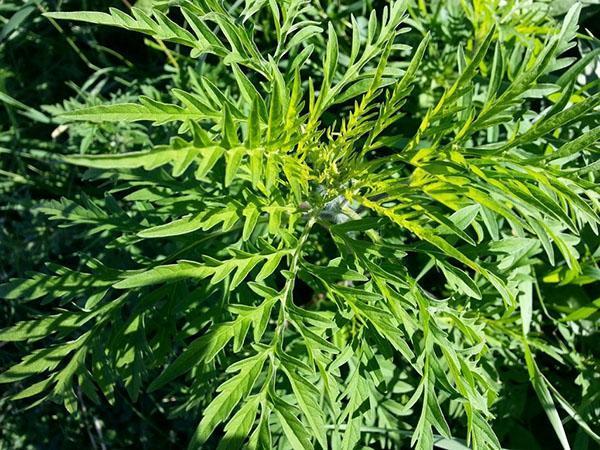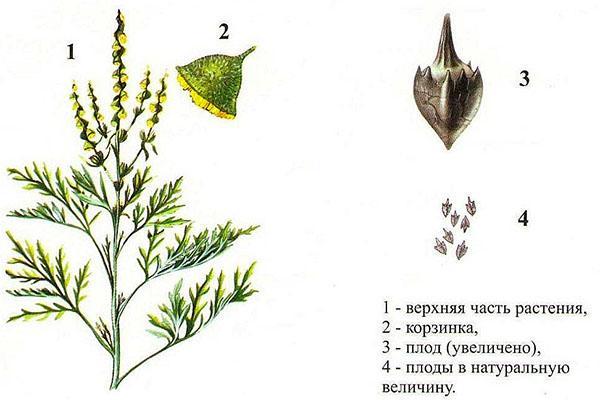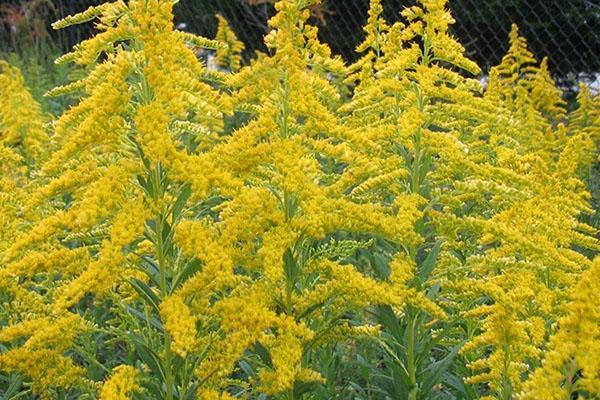Tips for allergy sufferers: what to do when ragweed blooms
 Summer is the hardest time for people with allergies. It is especially hard for them when ragweed blooms. Allergy manifestations can torment a person prone to it for a season so that health problems will be remembered until next year. If you or your loved ones do not feel well during the flowering of herbs, it is worth knowing better what it is - ragweed.
Summer is the hardest time for people with allergies. It is especially hard for them when ragweed blooms. Allergy manifestations can torment a person prone to it for a season so that health problems will be remembered until next year. If you or your loved ones do not feel well during the flowering of herbs, it is worth knowing better what it is - ragweed.
Description of the plant, species, origin

- tripartite,
- wormwood,
- holographic.
Ambrosia is ubiquitous in the Volga region, in the south of Russia and in the Crimea. In recent years, due to climate warming, its seeds have begun to ripen even in the middle lane.
The name of the plant comes from the Greek word ambrosia - this is how the food of the gods and the incense with which they rubbed was called in mythology.
Ragweed grows up to two meters in height, the root goes into the ground to a depth of four meters. Leaves are pinnately dissected, light green, younger ones are darker. Covered with short bristly hairs. Ambrosia reproduces only generatively. Each adult plant is capable of producing up to 150 thousand seeds per season.
In ragweed, seeds emerge at any stage of maturity - biological, waxy and milky. Freshly harvested seeds need a dormant period of up to 4–6 months, after which they remain viable for up to 40 years.
 Seedlings appear in May-June. Ambrosia blooms in late July - early August. Flowering continues until October. Small five-petal greenish-yellow flowers are collected in spike-shaped inflorescences. The seeds begin to ripen in August.
Seedlings appear in May-June. Ambrosia blooms in late July - early August. Flowering continues until October. Small five-petal greenish-yellow flowers are collected in spike-shaped inflorescences. The seeds begin to ripen in August.
Harm from ragweed
 The plant belongs to highly undesirable quarantine weeds, and there is every reason for this.
The plant belongs to highly undesirable quarantine weeds, and there is every reason for this.
Soil depletion
As soon as one ragweed sprout appears, in a few years the evil weed will cover everything with a solid carpet. This is facilitated by an exceptionally long root, which draws water from such depths where cultivated plants and wild plants do not reach.
As a result of the conducted field experiments, scientists have established: in order to grow its own weight of one kilogram, ragweed consumes almost a ton of water, 1.5 kg of phosphorus and 15 kg of nitrogen. In those places where this weed grew violently, the soil becomes unsuitable for cultivation for a long time.
Oppression of cultivated plants
The ragweed sprouts that have broken through in the spring quickly build up the green mass and shade the cultivated plants, taking away all the nutrients and water along the way. Crops sharply reduce the yield in those places where ragweed settled. The photo shows how quickly the plant conquers space.
Displacement of meadow grasses and wild plants
 In the same way, ragweed displaces all meadow grasses. If it gets into hay, its fodder quality is greatly deteriorated. Replacing honey plants, a weed is capable of significantly shaking the biological balance in a given biocenosis.
In the same way, ragweed displaces all meadow grasses. If it gets into hay, its fodder quality is greatly deteriorated. Replacing honey plants, a weed is capable of significantly shaking the biological balance in a given biocenosis.
The taste of milk quickly deteriorates, it develops an unpleasant, pungent smell and taste if the animal eats a blooming ragweed.
High allergenicity
According to the firm belief of allergists, ragweed pollen is one of the most powerful allergens, causing the so-called hay fever - a painful reaction of the body to the ingestion of pollen into the respiratory tract. In addition to developing an allergic reaction, it can provoke the development of asthma. A dangerous form of allergy is anaphylactic shock and the likelihood of subsequent development of pulmonary and cerebral edema.
A distinctive feature of pollen is considered to be the property of causing allergies even in healthy people who have never suffered from it. Allergies acquired in this way will manifest themselves every summer.
At a time when ragweed blooms, it is necessary to know the symptoms of the disease and take appropriate measures for treatment.
How to deal with allergies
 More than half of humanity currently suffers from allergies, and the number of allergy sufferers is only increasing every year. Therefore, even healthy people need to know the manifestations of allergies.
More than half of humanity currently suffers from allergies, and the number of allergy sufferers is only increasing every year. Therefore, even healthy people need to know the manifestations of allergies.
Disease symptoms
 When pollen comes into contact with the skin or mucous membranes in adults susceptible to hay fever, the following symptoms of ragweed allergy appear:
When pollen comes into contact with the skin or mucous membranes in adults susceptible to hay fever, the following symptoms of ragweed allergy appear:
- conjunctivitis, in which the eyes turn red, itching and watery eyes are observed;
- itching, accompanied by redness;
- sore throat with constant desire to cough and sneeze;
- allergic rhinitis with nasal discharge.
All this leads to the appearance of secondary factors of the disease. These include:
- unreasonable irritability;
- insomnia;
- frequent headaches;
- decreased concentration of attention;
- depressed mental state.
In a person with an allergy to ragweed, the eyes are the first to suffer.
When a runny nose and cough appears, you should make sure that this is a manifestation of hay fever, and not a cold.
Treatment methods
 When these symptoms appear, antihistamines are taken - anti-allergic drugs. The list of the most popular and effective drugs contains the following drugs:
When these symptoms appear, antihistamines are taken - anti-allergic drugs. The list of the most popular and effective drugs contains the following drugs:
- suprastin,
- claritin,
- tavegil,
- zyrtek,
- loratadine.
These drugs are available without a prescription, but it is best to consult with your doctor first so that he or she selects the most appropriate medication and dose.
The best remedy for the annoying symptoms of allergies every year is injections against the reaction. As a result of therapy, the body gets used to the irritant and does not react so painfully when ragweed blooms. The method is based on the regular introduction of small doses of the allergen to the patient intravenously.
Treatment with folk remedies
 In the question of how to treat an allergy to ragweed, recipes of traditional medicine will help. Decoctions and herbal infusions do not have such a pronounced effect as with the use of medicines, but they do not affect the liver and kidneys. With the next outbreak of hay fever, try the following folk remedies:
In the question of how to treat an allergy to ragweed, recipes of traditional medicine will help. Decoctions and herbal infusions do not have such a pronounced effect as with the use of medicines, but they do not affect the liver and kidneys. With the next outbreak of hay fever, try the following folk remedies:
- Celery and honey. Twist fresh leaves in a meat grinder, mix with honey, leave overnight. Take three scoops every day.
- Nettle. The decoction of the leaves is drunk a little half an hour before meals. Contraindicated in thrombophlebitis.
- Pine needles. Three tablespoons of rose hips are added to five tablespoons of chopped needles. The mixture is poured with boiling water and kept on low heat for 10-12 minutes. If the mixture is brewed in a thermos, boiling is not necessary. The broth is insisted and drunk during the day.

All of these recipes contain many vitamins and other useful substances. If they cannot alleviate suffering, then they will definitely strengthen the body and increase immunity.
Allergy prevention
Even before the onset of symptoms of an allergy to ragweed, you should attend to preventive measures. They will significantly reduce discomfort.
One of the most effective preventive measures is the right diet. For the summer, skip the following foods:
- all sweets;
- watermelon melon, peaches;
- sunflower seeds and oil from them;
- chamomile tea;
- pickles, smoked meats and marinades;
- any alcohol.
Some of the foods above contain pollen from Asteraceae. With their use, complications may develop, up to anaphylactic shock.
When ragweed blooms, doctors advise all allergy sufferers to follow these simple rules:
- keep windows and doors closed to prevent pollen from entering the house;
- install a special pollen filter in the air conditioner;
- carry out wet cleaning in the room every day - it is necessary to thoroughly wipe dust from all surfaces and wash the floor;
- take a warm shower before bed and wash your hair to prevent pollen from getting into bed - this is fraught with the development of hives;
- always bathe your pets after walking, as their coat carries pollen in large quantities.
Prevention of ragweed allergy is one of the most effective measures to protect your health. To avoid dangerous consequences, consult a doctor if the condition worsens severely.
Breeding stages of ragweed and the reasons for vitality

Ambrosia is most often carried to new places by the wheels of cars. As soon as one or two seeds sprout on the side of the road, a green border of this plant appears along it. If you do not take any measures, in a few years the whole field along the road will be filled with insidious weed. It will turn bright green where other plants begin to wither and degenerate.
Winds, on the wheels of cars and animal hair, ragweed seeds will continue their journey through fields, parks and vegetable gardens, generously sowing pollen.
There are several reasons for the phenomenal survivability of ambrosia:
- In North America, ragweed has natural enemies - insects and plants - that inhibit its growth and reproduction. In Russia, it has no pests, so ambrosia captures even poor saline soils.
- The weed easily survives any drought, since its roots penetrate to a great depth, where cultivated plants do not reach.
- Each ragweed bush gives up to 150 thousand seeds.
- If the cut flowering plants are not removed, unripe seeds can still sprout after a dormant period.
- Ambrosia seeds remain viable for up to 40 years.
Russian scientists carried out experiments on populating plantings with a leaf beetle imported from North America, where ambrosia serves as its only food. So far, these experiments have not been successful.
Control methods
 It is possible to defeat a tenacious weed only in one case - if you apply all possible measures for destruction in the complex and go to the end, until there is not a single plant left in a single territory. Similar actions should be applied in all regions where climatic conditions allow seeds to germinate. The most effective measures to combat a plant pest are:
It is possible to defeat a tenacious weed only in one case - if you apply all possible measures for destruction in the complex and go to the end, until there is not a single plant left in a single territory. Similar actions should be applied in all regions where climatic conditions allow seeds to germinate. The most effective measures to combat a plant pest are:
- Mowing - it is carried out only during the period of mass budding. If you start mowing a little earlier, the insidious weed begins to bush harder, releasing much more buds. After the first mowing, a few more are carried out per season in order to prevent the plant from blooming. This method is effective in fields, wastelands, along roads, in parks.

- Pulling out by the roots is a laborious method, but more effective. In a small area, it allows you to get rid of ragweed in a year or two.
- The chemical method is suitable for large areas where the first two methods will not bring visible results. Permitted pesticides on the territory of the Russian Federation include: roundup, glyphosate, glyphos, tornado, lauren, dominator, prima, clinics. Spraying with pesticides is prohibited in settlements, on pastures, in sanatoriums.

- Artificial tinning lawn grasses will help displace the weed from those places where it has occupied large areas, but the use of chemicals is prohibited.
Scientists have developed special mixtures of perennial legumes and lawn grasses, which quickly and amicably grow and suppress ragweed.The mixture includes awnless rump, rootless wheatgrass, foxtail, fescue and others. In the southern regions, experiments were successfully carried out on sowing Sarepta mustard, which completely cleared the experimental fields from the green pest.
Knowing what ragweed looks like, applying all the necessary methods to combat it and using preventive measures to protect against allergies, you will be able to significantly reduce the manifestations of the disease and protect yourself and your loved ones.